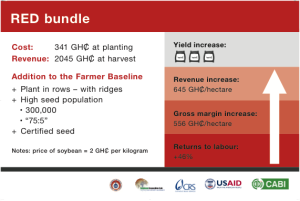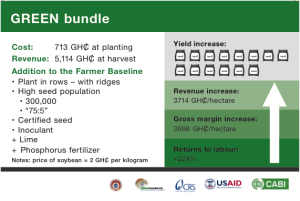Soybean Innovation Lab and CABI explore a stepwise investment approach using technology bundles
Duncan Sones of CABI-led Africa Soil Health Consortium project explains what has been going on in Northern Ghana.
The book Nudge explains the authors’ Nobel Prize-winning idea to adapt policy approaches to encourage people to make decisions that are in their broad self-interest. It’s not about penalizing people financially if they don’t act in certain way; rather it’s about making it easier for them to make a decision, nudging them in the right direction.
When it comes to soybean technologies there is a strong consensus about what works, the use of inputs and appropriate agronomic practices. And to a large extent farmers know what works. But despite this very few farmers have voluntarily purchased inoculant and only slightly more have paid for certified seed of improved varieties.
We started to ask, why has behaviour change in Northern Ghana been so slow?
And, what can be done to make it easier for soybean farmers to make better investment decisions?
One thought was that the research extension continuum has failed to nudge farmers in the right direction. What happens is that clever and well-meaning scientists undertake research to identify the optimum set of agricultural technologies. They share their results with the extension service. In the case of soybean they might say, plant very densely with 150,000 planting holes per acre, and add P fertilizer alongside (so that is 300,000 holes to make) . Get certified seed, add inoculant, and follow all the good agronomic practices. And then you will get a great crop.
The downside is that for each acre planted the farmers are presented with a USD $60 shopping list, excluding labour. Worse still, all of these inputs are needed at planting time, so cash flow is always an issue.
Without the addition of farm inputs, growing soybean is hard work for little reward. A yield of just 350 kg an acre and an income of USD $140 may be typical with saved seed and no inputs. But, for not a lot of additional work, and an investment of USD $60/acre, incomes can more than double to around USD $340 per acre due to large increases in yield. The economics look good – but only if you have access to USD $60 for the initial investment.
Even the best agricultural researchers seem to forget that they are making these recommendations to resource-poor smallholder farmers. For example, very precise planting details are shared as if all farmers need to do is calibrate a planting machine. In reality a family member pokes a hole in the soil with a stick and they don’t even have a tape measure!
Then, there is the money issue. Smallholder farmers have little access to credit and little or no savings. If farmers can borrow, and most banks are reluctant to lend, the interest rates are likely to be somewhere between 15-20%. So, investing the full USD $60 is unlikely.
But the scientists typically give no insight or advice as to how to break down the technology package into affordable chunks. What if the farmer only has USD $20 an acre to invest?
A chance conversation between staff from CABI and the Soybean Innovation Lab (SIL) led to a possible evidence-based way forward. SIL has carried out a series of omission trials, systematically excluding one technology at a time, to enable them to assess the impact of each individual agricultural practice and input.
They found that the best first step was the adoption of row planting and other good agronomic practices that required, plus the use of certified seed. This would cost just USD $20 per acre.
From these findings, SIL developed the idea of creating three bundles that build on a farmer’s current practice (the farmer baseline) and show estimated returns for each level of investment. Each bundle shows the next best step for each incremental investment.
The SIL team and CABI joined forces to create graphics to share this concept with decision makers at a workshop and subsequent field day event, SIL’s annual Soybean Kick-off, held in Ghana in mid-October 2018.
On 16 October 2018, a small group gathered together to explore the bundling concept as it was envisaged by SIL and partners. The idea met with approval as a way of trying to nudge farmers to make achievable, smart investments in their farms. The following day a group of around 200 NGOs, agro-dealers, researchers and farmers got together to consider this further.
What emerged was that:
- Farmers wanted information in acres not hectares
- Yields and costs could be shown in terms of bags
- People liked the idea of bundles and a clear investment pathways for farmers
- Issues still existed – such as access to credit and access to the inputs (seed, inoculant, phosphorous (P) fertilizer and lime)
- Bundles should probably include recommendations of weedicides / herbicides
- Most smallholder farmers could be encouraged to take up the less expensive red or yellow bundles
- The most expensive green bundle, containing lime and P fertilizer, is currently better suited to the medium to large-scale commercial farmers, or locations were a nucleus farmer is supporting small-scale farmers to engage in best practices.
There is still a way to go in developing a coordinated approach that energizes farmers, input dealers and extension teams to embrace this approach to bundling inputs. But the October workshop participants suggested that it may provide a breakthrough in creating behaviour change amongst small-scale smallholder farmers.
In November 2018 CABI, through its project Gender and the Legume Alliance (GALA), is carrying out a series of focus groups. These focus groups will be able to evaluate further the barriers to investment in legume inputs, and explore how the input bundles might make it easier for farmers to focus on next steps.
The GALA project is funded by the UK Department for International Development and supported through the Sustainable Agricultural Intensification Research and Learning in Africa (SAIRLA) programme.
The Soybean Innovation Lab is funded by U.S. Agency for International Development’s (USAID)



